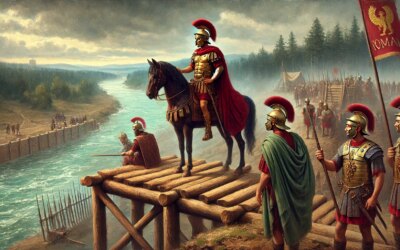Introduction: The Edge of Empire
By the late 4th century AD, the Roman Empire was still vast but increasingly fragile. Nowhere was this tension more apparent than on the Danube frontier—a contested boundary between imperial order and barbarian chaos. In 375 AD, the aging and formidable Emperor Valentinian I stood face-to-face with Germanic envoys in a dramatic episode that illustrated both the power and peril of Roman diplomacy. The confrontation would be his last—and one of the most revealing episodes in late Roman history.
The Emperor of the West
Valentinian I had ruled the Western Roman Empire since 364 AD, following the death of Jovian. A former military officer, he was pragmatic, devout, and known for his harsh discipline. Unlike many predecessors, he spent little time in Rome, preferring to rule from the frontiers. He had weathered multiple threats—from Alamanni invasions in Gaul to internal revolts in Africa—earning a reputation as one of the most capable emperors of the century.
Barbarians at the Danube
The Danube River served as a natural border between Roman-controlled Pannonia and the lands of various Germanic peoples, including the Quadi and Sarmatians. Tensions had flared repeatedly. In the early 370s, a Roman military installation on land claimed by the Quadi triggered renewed hostilities. Germanic raids increased, prompting Valentinian to lead a campaign to secure the frontier.
The Meeting at Brigetio
In the autumn of 375, Valentinian camped at Brigetio (modern Komárom, Hungary) on the Danube’s banks. Germanic envoys arrived, seeking to negotiate terms. Contemporary sources, notably Ammianus Marcellinus, describe a tense, heated exchange. The emperor, already unwell, became enraged by what he perceived as insolence and betrayal. His fury escalated rapidly—he shouted, gestured violently, and reportedly suffered a massive stroke mid-speech.
The Sudden Death of an Emperor
Valentinian collapsed on the spot. Despite attempts by his aides to revive him, he died shortly after—on November 17, 375. His unexpected death shocked the court and left a power vacuum in the West. His young son Gratian was elevated to the purple, but the political stability Valentinian had maintained now rested on untested shoulders. In the East, Valens still ruled, preoccupied with his own threats—including the gathering storm of the Goths.
Legacy of Valentinian I
Though not always loved, Valentinian was respected. He reinforced the Danube frontier, improved provincial administration, and defended Christianity while allowing limited religious tolerance. His death at the height of a diplomatic confrontation symbolized the fragile balance between Roman might and barbarian negotiation. It also marked the end of an era of strong imperial hands-on leadership in the West.
Rome’s Shifting Boundaries
The Danube crisis of 375 AD foreshadowed the greater invasions to come. Within decades, the Goths would cross the river en masse, and the Western Roman Empire would begin its terminal decline. Valentinian’s final act—a fury-laced stand against foreign intrusion—captured the spirit of a state desperately trying to hold its borders against forces it no longer fully understood or controlled.
Conclusion: The Last Roar
Valentinian I’s death in 375 AD was not just the end of a reign—it was the end of a particular Roman posture. At Brigetio, amid the cold mist of the Danube, an emperor’s rage and resolve met the limits of flesh and fate. His collapse did not merely silence his voice—it signaled the growing vulnerability of a world that had once believed itself eternal.






